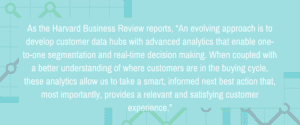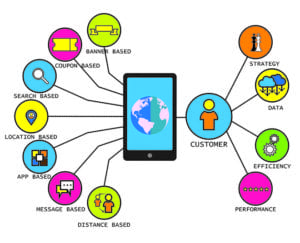Are You Using Data to Shape Your Customer’s Journey?

“We saw you looking …”
This was the subject of an email I opened from the women’s clothing store LOFT after an afternoon of browsing their online store. It continued:
“We know you pretty well (and we think you’ll love these).” The pictures below the text were images of a few pairs of jeans I had clicked on and a few other pieces that complemented those jeans. They were right. I did, in fact, love them.
It’s hard to imagine Mad Men’s Don Draper and his team crafting an advertisement like this, but then again, the customer journey is almost unrecognizable now to what it was back then.
In the days of Mad Men, the customer journey was simple, predictable, and easy to map: a customer saw or heard an advertisement and simply went out and purchased the product/service in stores. There were other steps, of course: weighing options, getting recommendations from friends, price checking. But companies did not have many other touch points with consumers along the way.
The donor journey of today, however, is not so linear. It involves an infinite combination of online, mobile, and in-person interactions that shape whether or not consumers purchase products and services: emails, websites, apps, social media, online reviews, searches, and chats are all part of the game now — in addition to print, radio, and television ads and in-store interactions. It’s no wonder there is a constant conversation about how to make sense of all the data collected during these interactions and the best way to track these journeys.
Luth Research found that some customers have as many as 900 digital touch points (including searches, clicks, website visits, and video and image views) when purchasing a car — and most take place on mobile devices. They look at the example of a consumer named Stacy, who in the months-long process of considering, researching, testing, and eventually purchasing a car conducted 139 searches, watched 14 YouTube videos, perused 89 images, and interacted with 69 dealers and 186 manufacturers.
All these interactions in the modern customer journey collect an amazing quantity and quality of data about your customers, though it’s often unfocused and disjointed due to the various channels in which customers engage. “Email data might be sitting in a system separated from Web analytics, which is separated from mobile, which is separated from social,” says Bruce Swann, Senior Product Marketing Manager for Adobe. But once this data is consolidated using emerging data analytics technology, you should be able to identify clear trends and patterns that will help you develop a few “personas” that represent your customer base and their and behaviors.
How To Use the Data
Data has traditionally been used to segment customers into various audiences and market to these segments based on demographics such as age, gender, geographic location, or life stage. Companies have the ability to segment out 18-24 year-old men, first-time homebuyers, or women who have previously purchased a Swiffer sweeper, for example, and create targeted messaging just for that group.
But the customer journey is not one-size fits all (or even 10 or 100 sizes fit all!), and traditional demographic targeting, such as email blasts, is no longer acceptable. Customer expectations have shifted, and being marketed to as part of a group is no longer enough. Customers like me no longer simply want to be just known, but wellknown. We are used to seeing banner and Facebook ads for hotels after searching for flights, or emails about houses for sale near you after browsing Zillow. We aren’t unnerved by “We saw you looking …” emails — we expect them.

Companies are now utilizing data and real-time analytics of customer behavior in order to create a customized path to purchase that is ever evolving based on customer actions. So utilizing this one-to-one segmentation, LOFT used my behavior (putting a pair of jeans into my cart, hesitating, and ultimately abandoning the cart) to send me a customized email that would attempt to funnel me further through the customer journey toward purchase. Similarly, companies now know (through collected data), exactly where each of their customers is in their journey and provide personalized marketing to them in real time.
Customer Journey Mapping
This type of one-to-one personalization makes tracking the customer journey challenging, as no two paths are the same. Google “customer journey mapping,” and you’ll find hundreds of thousands of tutorials, articles, and templates that promise to help you better understand your customer’s path to purchase. They’ll also tell you honestly how time-consuming it is to map these kinds of journeys. Wharton marketing professor Jerry Wind says, “Mapping is very difficult given the heterogeneity of all markets and [also because] the same consumer may have a totally different journey at different times because of different contexts.”
Customer journey maps of today do not look like the single, linear maps of the Mad Men era. Instead, a series of connected maps must be created based on those customer “personas” you identified through data collection. Rather than tracking these customers based on things like age or income level, it is now more beneficial to track customers based on how often they purchase, the channel they purchase on, or where their search initiates. These maps must be flexible and able to evolve quickly depending on any one customer’s context and decisions. Despite the challenges in mapping these kinds of customer journeys, it is still a beneficial exercise for a number of reasons.

Mapping the customer journey requires that all members of a team come out of their silos and identify possible areas of friction or missed opportunity at each touch point with the customer. It is important in this multi-channel age that teams take the time to make sure that all messaging across channels is consistent and focused, making the purchasing process as seamless as possible. As important as locating your weaknesses is, it is also valuable to locate your strengths such as “areas that lead former customers back to your brands, and which touch points inspire online engagement in the form of reviews, referrals, likes, or shares,” says Daniel Newman of Converge. Analyzing various customer journeys will give you a holistic view of your customer, which can be used to make each interaction intensely personal and one-of-a-kind.
The Future of the Customer Journey
So what will be the “next big thing” in using data and analytics to map the customer journey? According to David C. Edelman and Marc Singer of the Harvard Business Review, most companies are too busy trying to “understand their customers and wrestle back control […] anticipate their next moves and positions themselves in shoppers’ paths.” They suggest that competitive leaders in the market are those who make the shift to using data and analytics to control and shape the customer journey instead of just reacting to customer behavior.
They give the example of solar panel provider and installer Sungevity, who has a seamless customer journey that anticipates what customers need and want — before they are even aware of it themselves!
The process began when [one of the authors, David Edelman] received a mailing with the message “Open this to find out how much the Edelman family can save on energy costs with solar panels.” The letter within contained a unique URL that led to a Google Earth image of David’s house with solar panels superimposed on the roof. The next click led to a page with custom calculations of energy savings, developed from Sungevity’s estimates of the family’s energy use, the roof angle, the presence of nearby trees, and the energy-generation potential of the 23 panels the company expected the roof to hold.
Next, he was led to an online customer service representative who had all his relevant information in front of him and could lead him through any questions about the process, even sending videos for reference. Rather than waiting for him to search online reviews, Sungevity sent him the names and numbers of neighbors who had installed Sungevity panels in the past. Each time he connected with customer service, they knew exactly where he was in the journey and helped him take the next step, until he eventually became a customer! Even now, he receives reports on his energy and cost savings along with tips to save even more.
Phew! Now that is how to use data and analytics seamlessly and effectively to eliminate all other competition and create satisfied and loyal customers! Is this the future of the customer journey?
It is exciting to think about how other companies could lead customers through the journey rather than simply reacting to their every whim — offering something that customers didn’t even know they needed! Perhaps car companies, for example, could use available data to design the perfect vehicle for a family’s size, budget, amount of time spent driving, and geographic location — along with safety ratings and reviews from customers in your area. Or maybe hotels and tourism companies will be able to offer up an itinerary for a getaway you didn’t even know you needed — with TripAdvisor ratings of each scheduled stop and customer service reps standing by to answer any questions about your activities.
And will clothing retailers start sending me personalized wardrobes, price comparisons, and nearby references of people of similar ages and sizes who bought the same piece of clothing? Sounds great to me! Game on, LOFT!
